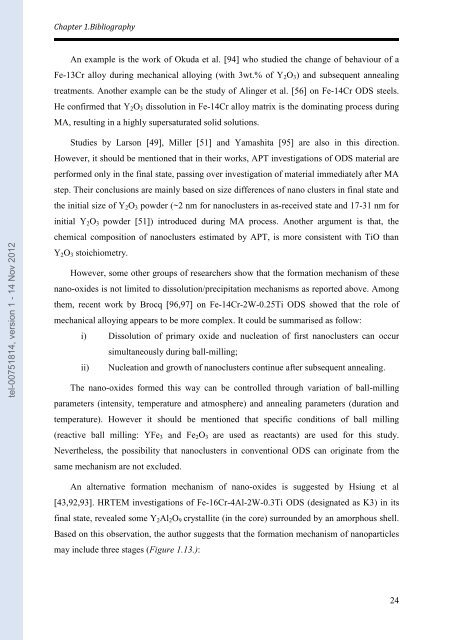Etude par Sonde Atomique Tomographique de la formation de nano ...
Etude par Sonde Atomique Tomographique de la formation de nano ...
Etude par Sonde Atomique Tomographique de la formation de nano ...
Create successful ePaper yourself
Turn your PDF publications into a flip-book with our unique Google optimized e-Paper software.
tel-00751814, version 1 - 14 Nov 2012<br />
Chapter 1.Bibliography<br />
An example is the work of Okuda et al. [94] who studied the change of behaviour of a<br />
Fe-13Cr alloy during mechanical alloying (with 3wt.% of Y2O3) and subsequent annealing<br />
treatments. Another example can be the study of Alinger et al. [56] on Fe-14Cr ODS steels.<br />
He confirmed that Y2O3 dissolution in Fe-14Cr alloy matrix is the dominating process during<br />
MA, resulting in a highly supersaturated solid solutions.<br />
Studies by Larson [49], Miller [51] and Yamashita [95] are also in this direction.<br />
However, it should be mentioned that in their works, APT investigations of ODS material are<br />
performed only in the final state, passing over investigation of material immediately after MA<br />
step. Their conclusions are mainly based on size differences of <strong>nano</strong> clusters in final state and<br />
the initial size of Y2O3 pow<strong>de</strong>r (~2 nm for <strong>nano</strong>clusters in as-received state and 17-31 nm for<br />
initial Y2O3 pow<strong>de</strong>r [51]) introduced during MA process. Another argument is that, the<br />
chemical composition of <strong>nano</strong>clusters estimated by APT, is more consistent with TiO than<br />
Y2O3 stoichiometry.<br />
However, some other groups of researchers show that the <strong>formation</strong> mechanism of these<br />
<strong>nano</strong>-oxi<strong>de</strong>s is not limited to dissolution/precipitation mechanisms as reported above. Among<br />
them, recent work by Brocq [96,97] on Fe-14Cr-2W-0.25Ti ODS showed that the role of<br />
mechanical alloying appears to be more complex. It could be summarised as follow:<br />
i) Dissolution of primary oxi<strong>de</strong> and nucleation of first <strong>nano</strong>clusters can occur<br />
simultaneously during ball-milling;<br />
ii) Nucleation and growth of <strong>nano</strong>clusters continue after subsequent annealing.<br />
The <strong>nano</strong>-oxi<strong>de</strong>s formed this way can be controlled through variation of ball-milling<br />
<strong>par</strong>ameters (intensity, temperature and atmosphere) and annealing <strong>par</strong>ameters (duration and<br />
temperature). However it should be mentioned that specific conditions of ball milling<br />
(reactive ball milling: YFe3 and Fe2O3 are used as reactants) are used for this study.<br />
Nevertheless, the possibility that <strong>nano</strong>clusters in conventional ODS can originate from the<br />
same mechanism are not exclu<strong>de</strong>d.<br />
An alternative <strong>formation</strong> mechanism of <strong>nano</strong>-oxi<strong>de</strong>s is suggested by Hsiung et al<br />
[43,92,93]. HRTEM investigations of Fe-16Cr-4Al-2W-0.3Ti ODS (<strong>de</strong>signated as K3) in its<br />
final state, revealed some Y2Al2O9 crystallite (in the core) surroun<strong>de</strong>d by an amorphous shell.<br />
Based on this observation, the author suggests that the <strong>formation</strong> mechanism of <strong>nano</strong><strong>par</strong>ticles<br />
may inclu<strong>de</strong> three stages (Figure 1.13.):<br />
24

















